Teatime Tastiness: Lady Baltimore Cake Story and Recipe
 Wednesday, February 27, 2013
Wednesday, February 27, 2013 Here’s a cake that was built for genteel tea parties: a large layer cake filled with chopped nuts and dried fruits and topped with a dramatic (but ever ladylike) billow of boiled frosting. But while one might suppose that this distinguished cake was named after Lady Baltimore, that's not quite how the story went. Like many cakes, its origins are disputed--but like any teatime gossip, this makes the story so much more fun to delve into. A very helpful resource in my delving was The Old Foodie, by the way. Oh, and if you like tales like this, you should probably pre-order my new book, The Secret Lives of Baked Goods: Sweet Stories & Recipes for America's Favorite Desserts.
Let's start with the tales that are likely false. First: the Lady Baltimore connection. Highly unlikely that the cake dates back to her day: the Lady, whose Irish husband inherited Maryland in the mid-seventeenth century, never even lived in America, and in any case baking powder leavening agents were not invented until well into the nineteenth century – making a cake of this sort not very likely to have been invented as a casual teatime treat during her day. The Big Fella of American Cookery, James Beard, says of Lady Baltimore that it is “said to have originated in Maryland, this one one of the first fine-textured cakes mentioned in old cookery books. It required a delicate touch in mixing and exact measurements--this, in the days of no standard measuring cups, teaspoons, or tablespoons.” Second: the Dolley Madison connection. Some say that the cake rose in popularity due to the fact that it was similar to a cake enjoyed by Dolley Madison, the fourth First Lady but this story fails to explain why it is not then called Dolly Madison cake. Also, she's already got an ice cream named after her—isn't that enough?
And now, the favored explanations for the cake—likely, the true story is a combination of the two. First: It originated in Charleston at the end of the nineteenth century, at “The Lady Baltimore Tearooms”, and was a variation of another popular cake.
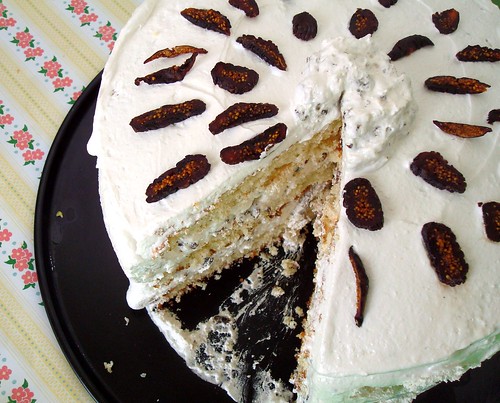
Second: novelist Owen Wister is the one who made this cake famous--while writing his 1906 romance, Lady Baltimore, set in a fictional city based on Charleston, he was extremely taken with the city and a cake he ate there. In fictional form, it is described as being not unlike a wedding cake, and the suggestive passage is as follows:
"I should like a slice, if you please, of Lady Baltimore," I said with extreme formality. I thought she was going to burst; but after an interesting second she replied, "Certainly," in her fit Regular Exchange tone; only, I thought it trembled a little.
I returned to the table and she brought me the cake, and I had my first felicitous meeting with Lady Baltimore. Oh, my goodness! Did you ever taste it? It's all soft, and it's in layers, and it has nuts--but I can't write any more about it; my mouth waters too much.
Upon reacting in a strongly favorable way, the narrator realizes that the girl he’d been speaking to was the cake-maker. He finds that it has broken the ice, and their sweet flirtation continues. Some say that it is an instance of art imitating life: could it be possible that Wister had been served some delicious cake by an appealing Southern belle, and was inspired to immortalize the experience?
Supporting this is the fact that there seems to be no mention anywhere of a cake called “Lady Baltimore” until the first known publication of the recipe in 1906. Suddenly there was a flood of newspaper articles mentioning the cake; one writer in 1907 only agreeing to part with the recipe ‘with the sanction of Owen Wister’. Most likely? The cake preceded Wister's novel, but was renamed toute-suite after the novel's popularity became evident. Perhaps some entrepreneurial cake-shop owner took note after reading the book and tweaked the recipe to live up to the novel. Perhaps it was even the ladies at the Lady Baltimore Tea Rooms in Charleston.
Lady Baltimore, in cake form, has a male companion: the Lord Baltimore Cake. This yellow cake variation was created as a clever way to use up all of the egg yolks discarded while making the Lady version of the cake, yielding a rich, decadent counterpart.
Delicate and fine-crumbed, this cake is nicely paired with the rich fillings and toppings which keep it from being too light and angel food-like. Precision with the cake is necessary to get the “lift” from the egg whites, but it's worth the effort: it makes for sweet, easy eating, and the cake's history will make for some fascinating conversation.
Lady Baltimore Cake (printable recipe here!)
16 servings
- 3 cups flour
- 1 tablespoon baking powder
- 1/2 teaspoon salt
- 1 cup (2 sticks) unsalted butter, softened
- 2 cups sugar
- 2 teaspoons vanilla extract
- 1 cup milk
- 7 large egg whites
- 1/4 teaspoon cream of tartar
Boiled frosting (recipe follows)
- Preheat the oven to 325 degrees F. Grease and flour the bottoms and sides of three 8-or 9-inch round cake pans; line with rounds of parchment paper.
- In a large bowl, sift together the flour, baking powder, and salt. Set aside.
- In the bowl of a stand mixer fitted with the paddle attachment, cream the butter with the sugar until the mixture is light and fluffy, about 3-5 minutes on medium speed. Stir in the vanilla.
- Add the flour mixture to the butter mixture in 2-3 additions, alternately with the milk, and stir the batter until it is just combined.
- In another large bowl, beat the egg whites, cream of tartar, pinch of salt until they form stiff peaks.
- Stir a portion of the egg whites into the batter to lighten the mixture; follow by gently folding in the remaining whites.
- Divide the batter evenly among the prepared pans. Use a spatula to smooth the top of the batter in the pans.
- Bake for 25-35 minutes, or until a tester comes out clean.
- Let the cake layers cool in the pans on racks for 10 minutes, turn them out onto the racks, and let them cool completely. If the cakes have formed a dome on top, slice using a serrated knife to level.
Boiled frosting
- 6 large egg whites
- 2 cups sugar
- 3/4 cup water
- 2 teaspoons vanilla extract
- 1/2 cup finely chopped dried figs plus sliced dried figs for garnish
- 1 cup pecans, toasted lightly and chopped fine, plus pecan halves for garnish
- 1/2 cup raisins, chopped
- In the bowl of a stand mixer, beat the egg whites until they hold soft peaks. Set aside.
- In a small saucepan over medium-high heat, combine the sugar and the water, stirring occasionally. Once it comes to a boil, continue stirring, more frequently, until the sugar is dissolved; boil the syrup until it registers 248 degrees F on a candy thermometer.
- With the mixer running add the hot syrup to the egg whites, in a slow, steady stream.
- Add the vanilla, beating the icing until it is smooth and cool.
- Transfer two cups of the frosting to a bowl. With the remaining portion of frosting, fold in the chopped figs, pecans, and raisins.
- Place the first cake layer on a serving plate, flat (un-cut) side up. Spread it with half of the fruit and nut-filled frosting, keeping a ½ inch margin around the edges—the weight of the next layer will spread the filling to the edges. Place another cake layer on top of the frosting, once again so that the flat side faces up. Spread the remaining fruit and nut-filled frosting on top of this layer, once again leaving a margin. Place the third cake layer on top, flat side up. Use the reserved plain frosting to frost the top and sides of the cake. Garnish with any remaining fruit or nuts.
 cake history,
cake history,  cakes,
cakes,  recipes
recipes 








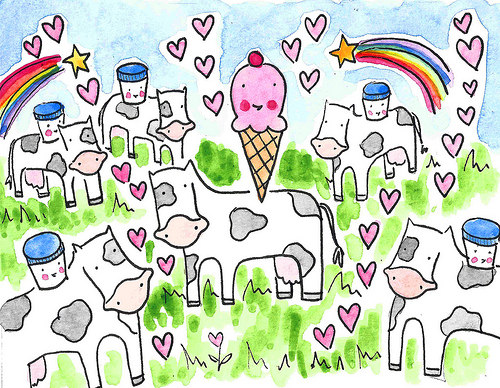
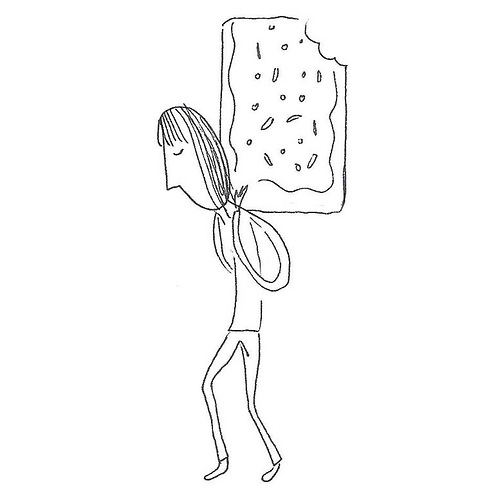


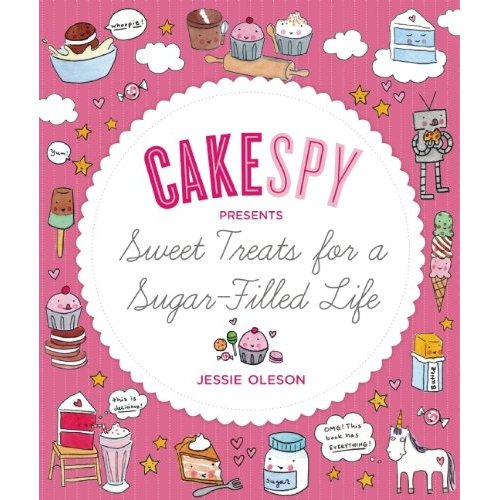
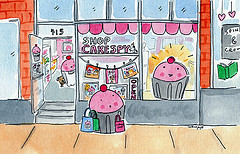

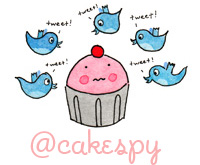
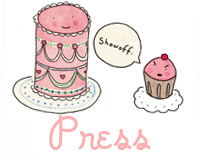

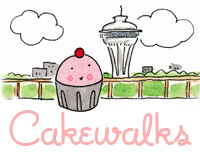
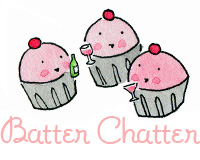

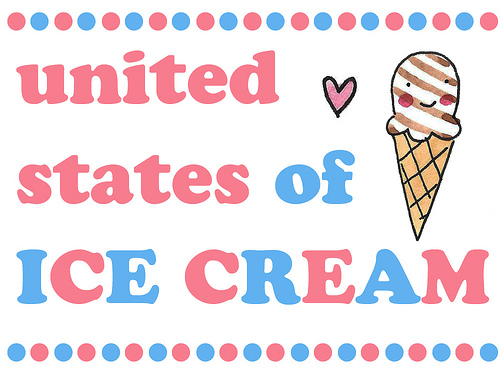


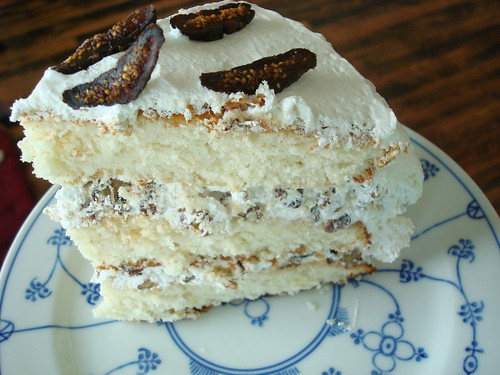
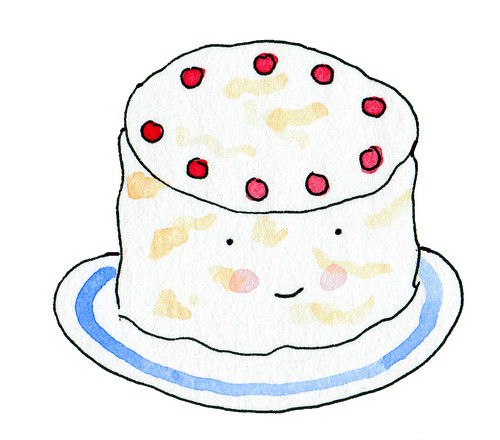
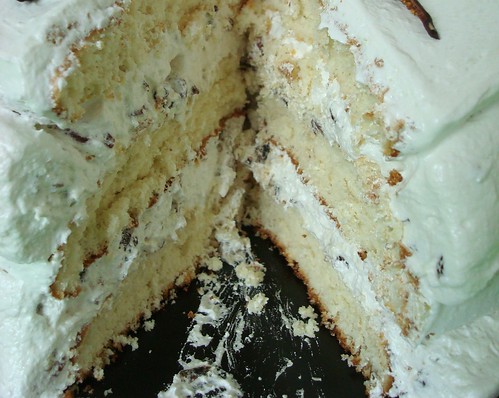
Reader Comments